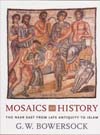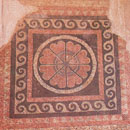| |
Mosaics as History - The Near East from Late Antiquity to Islam
by G. W. Bowersock
This is an unusually long review, but then this is an unusually important book. It's about the mosaics of the Holy Land. It was in fact an earlier book, "Mosaics of the Holy Land" by Meir Ben Dov and Yoel Rappel (Adama Books 1987), which first made it excitingly clear to me that the region is chock-a-block with recently discovered mosaics from “Late Antiquity”. But this new book has exciting new things to tell us about them.
As you would expect, Holy Land mosaics first became common from the time of the Roman invasion in the first century BC. They were to be seen in public buildings, such as Herod the Great’s palace at Masada, which had some fine “rug” mosaics; and in private houses. They were of course non-figurative – no human beings or animals, still less pagan gods and goddesses. Geometrical patterns and stylized flowers were the order of the day.
But it seems that the Holy Land mosaic business really took off in AD 313, when the Emperor Constantine made it legal to be a Christian in the Roman Empire, and what we now call the Early Byzantine period began. Churches mushroomed everywhere, and in them mosaic floors and walls were de rigeur. Of course private houses and public buildings continued to flaunt mosaics, as they had for centuries.
Now what’s interesting about many Holy Land mosaics from the fourth to the seventh century is that clearly the traditional ban on portraying animals and human beings and gods evaporated. For instance, we find a synagogue at Hammath Tiberias with a perfectly orthodox floor mosaic of the Torah Ark flanked by menorahs – but next to that we see the four seasons personified, the signs of the zodiac (animals and people), and presiding over all the Sun God, Helios, driving his chariot!
How times change. Christian churches and buildings were adorned similarly – at Beth Shean the main hall of a monastery had a mosaic with a man and woman as the sun and moon, surrounded by the twelve months, each illustrated by people doing something suitably agricultural. And a monastery in Jerusalem had a mosaic of Orpheus…
Which is where "Mosaics as History" comes in. Professor Bowersock makes it clear that in the Byzantine Near East classical mythology flourished like the green bay tree: Theseus, Ariadne, Hippolytus, Phaedra, Bacchus, Dionysus, Prometheus, Heracles, Achilles – Jews and Christians, whether mosaicists or not, knew all about them and wanted to see them. On the floor. (And on the walls? We don’t know, they haven’t survived.) Normally the standard version of the legends was depicted, but there could be variants. For example, the traditional story of Cassiopeia is that she went around boasting she was more beautiful than all fifty Nereids (sea-going classical crumpet) rolled into one, and she was duly punished by being bound to her chair and made to circle the pole star upside down. Silly girl. However the Lebanese residents near Mount Casios had other ideas about their eponymous heroine, and mosaiced her crowned, an easy winner, eat your hearts out, Nereids.
Another popular story was the drinking contest between Heracles and Dionysus; it’s been argued that a mosaic of this at Sepphoris in Galilee was actually in the house of the Jewish Patriarch there. Sepphoris, four miles from Nazareth, was a major city, with fabulous mosaics. One image of a woman is so lovely it’s been christened “The Mona Lisa of Galilee”. She dates from the third century, so sadly Jesus could never have seen her.
(Incidentally you will occasionally come across religion-bashers claiming that Nazareth never existed in the time of Jesus of Nazareth. Happily archaeology has knocked that particular canard on its head. For instance, in the 2008 issue of the Bulletin of British Byzantine Studies Dr. Ken Dark of Reading University reported on the progress of the Nazareth dig he was heading. His primary interest was in Byzantine-period remains, such as a large church with a mosaic floor and polychrome wall mosaics. But he also reported that in the early Roman period Nazareth did indeed exist; it was a small, low-status village. [“Can anything good come from Nazareth?” John 1:46.] It had few masonry structures, which presumably means the other buildings were of wood. Plenty of work for a local carpenter called Joseph and his son, therefore. Though they may have worked in stone as well – the Greek word tekton, usually translated as carpenter, actually means more like jobbing builder. It’s been pointed out that in his parables Jesus talks about building rather than carpentry. The only other jobs available in Nazareth were quarrying and agriculture.)
So there they were, all over the Holy Land, hundreds of mosaic images of classical gods, nymphs and heroes. Prof. Bowersock argues persuasively they reflected the immensely popular mime theatre of late antiquity, which frequently starred classical gods, nymphs and heroes. We know Christians went to see these shows, because they were told not to. They even performed in them. Sometimes there would be a single dancer, a “mime”, who silently acted all the roles, using masks and movement. Sometimes there was a script, spoken by unmasked performers, actors - and actresses. Gosh. No wonder the clergy got upset. And it was the themes beloved by mosaicists that featured in the shows. So the mosaics give us a good idea as to what you saw when you supported your local theatre, in Sepphoris or wherever. Here were Phaedra and her whispering servants, there was Hippolytus’s servant beating the nurse, yonder was the balding falconer… And now for Amazons, bare-breasted, no really… No wonder the clergy got upset. Dionysus has a lot to answer for. So has Alexander the Great, who brought Hellenism to the Holy Land.
One gets the impression that the region was full of flourishing towns and cities, and the famous Madaba Map confirms this. What’s more, surviving mosaics confirm a very specific kind of civic pride. In the immense City Mosaic in the Church of St. Stephen at Umm Er-Rasas there are images of many towns in the Holy Land, each sporting some prominent piece of architecture – say, a column in a square.
Apparently, throughout the Near East, individual mosaicists were free to chose which architectural gem of a given city they wished to immortalize; it didn’t have to be as rigid as London = Big Ben. And they were pretty accurate, so here too these mosaics show us things we can no longer see with our own eyes. Indeed the Madaba Map shows lots of lost towns in the Negev desert south of Jerusalem. Doubtless one day we’ll dig them up.
There is more to be gleaned. In the Hippolytus mosaic at Madaba there are three tychai, titular goddesses of cities, labelled Rome, Gregoria and – unsurprisingly – Madaba. “Rome” seems self-evident, but what was “Gregoria”? Prof. Bowersock concludes that at that period “Rome” actually meant Constantinople, the new Rome. Gregoria must therefore be the city next in importance to Constantinople, Antioch, renamed in honour of Gregorius, the famous patriarch of Antioch at the time the Hippolytus mosaic was made. And we only know that from this one mosaic. Mosaics as History indeed.
The Arab blitzkrieg around the Mediterranean began shortly after the death of Mohammed in 632, and just six years later they had conquered the Holy Land. Quite a crusade. The Arabs found they liked living in the Byzantine Empire and adopted or imitated a great deal, including churches, palaces and mosaics (see our Feature Item "What Islam Took From Byzantium"). Spectacular those mosaics were. And some were figurative, not in the mosques, but in the palaces - the Koran doesn’t forbid the depiction of living beings. That ruling came later. And iconoclasm with it.
A great many church and synagogue figurative mosaics were disfigured in the eighth century, though by no means all were, and till recently it was thought that gangs of Arabs roamed around, smashing them up. Prof. Bowersock, however, convinces us that what actually happened was this - in 723 the Caliph Yazid II ordered the destruction of figures, and in a good many churches and synagogues the Christians and Jews carefully removed the figures, leaving the rest of the mosaic intact.
However Yazid died a few months later and his successor at once rescinded the order. It’s probable that some Jews were happy to destroy images of figures, by way of returning to their roots, and it may be that a few Christians were also. Interestingly, in the early centuries of Islam some Muslims used to pray in Christian churches, and a governor of what is now Iraq built a church in honour of his mother, who was a Christian.
You will have gathered that "Mosaics as History" is scholarship at its best. Prof. Bowersock shows us how the mosaics of the Holy Land reflect a world that from the fourth to the seventh century was largely peaceful and immensely diverse, with the faithful of different religions sharing the common heritage of Hellenism. “The late-antique Near East was a kind of miracle,” he writes, “and its like has never been seen in that region again.” One can only agree.
Paul Bentley
Price: £16.95 |






